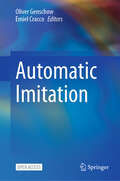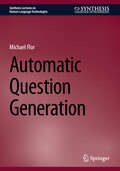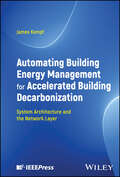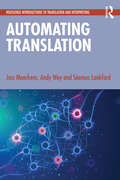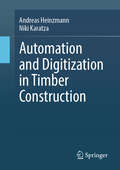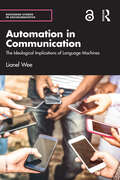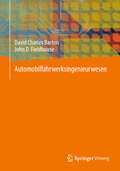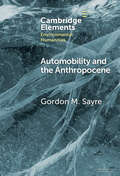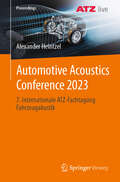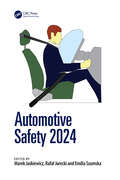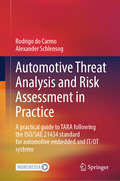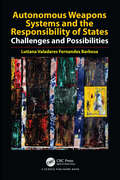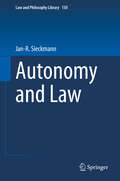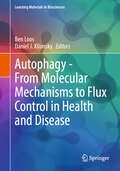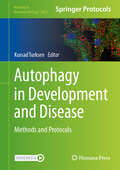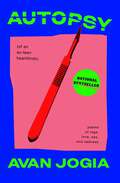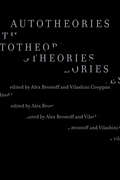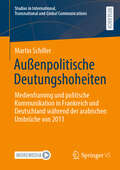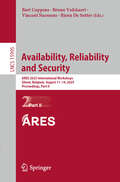- Table View
- List View
Automatic Imitation
by Oliver Genschow Emiel CraccoPeople spontaneously imitate a wide range of different behaviors. The interest in this phenomenon dates back to at least the 18th century when Adam Smith (1759) argued that imitation can be seen as a primitive form of sympathy. Despite the longstanding interest, it was not until the 20th century that different research fields within psychology and neuroscience started empirically investigating this social phenomenon. This book brings together leading researchers from various domains to provide readers with a recent overview of developments in automatic imitation research. This is an open access book.
Automatic Question Generation (Synthesis Lectures on Human Language Technologies)
by Michael FlorThis book provides an overview of the fundamentals of Automatic Question Generation (AQG) for computational linguistics researchers, test developers, and educators. The author presents a variety of AQG system architectures, including generating questions from syntactic analyses, semantic resources, neural architectures, ontologies and knowledge graphs, and large language models. The advantages and pitfalls of a variety of AQG evaluation methods, including multi-aspect ratings by human experts, end-users, as well as crowd-sourcing and automatic evaluation techniques are discussed. The book also provides a roadmap of options for AQG targeted orientation, content selection, and focusing decisions. Machine learning opportunities for training systems to generate questions based on human-generated examples are also explored. This book offers greater depth and breadth than previous surveys of AQG. Readers will gain a comprehensive knowledge of current research, examples of applications of AQG, and inspiration for future directions for innovation and application.
Automating Building Energy Management for Accelerated Building Decarbonization: System Architecture and the Network Layer
by James KempfComplete, up-to-date reference on system architecture for building energy management systems Automating Building Energy Management for Accelerated Building Decarbonization delivers detailed technical information on building energy management control technology and guidelines to implementing and deploying building energy management systems. The book provides a detailed look at the system architecture of cloud-based building energy management systems, and a comprehensive review of technology for the networking layer, from the link layer through the application layer. Wired and wireless link layer protocols, and Internet network layer protocols from the TCP/IP suite are thoroughly reviewed, and discussed in the context of deploying an in-building, operational technology network. At the application layer, BACnet, for large commercial and government buildings, and Bluetooth Low Energy, Zigbee, and Matter, for smaller commercial and residential buildings, are discussed in detail, with focus on energy management and building decarbonization. The API standards OpenAPI 3.1 and AsyncAPI 3.0 are used to define example APIs for controlling an HVAC system, illustrating how to provide API abstractions that simplify the development of building energy management applications and services. Finally, a discussion of controlling onsite distributed energy resources, such as solar panels and on-site battery storage, through SunSpec Modbus, and communicating with the utility through OpenADR and IEEE 2030.5 provide a solid technical foundation for implementing communication services in demand response and flexible load applications. Security is emphasized as a key property for the operational technology networks that run building energy systems up and down the stack. At the architectural level, security functions including data origin authentication, confidentiality protection, and key exchange are discussed in detail. Detailed information on security protocols including IPsec at the network layer, TLS at the transport layer, and Oauth2.0 at the application layer is presented. In addition, advice on deploying security solutions in building energy management networks is provided. Throughout the book, QR codes provide access to short videos about topics where more depth is needed or that are only briefly covered. These allow the reader to view more information about important topics. Automating Building Energy Management for Accelerated Building Decarbonization is an essential resource for managers, engineers, and other professionals involved in designing and building energy management services for commercial and residential buildings. It is also an excellent reference for university and training courses related to building decarbonization and renewable energy.
Automating Translation (Routledge Introductions to Translation and Interpreting)
by Joss Moorkens Andy Way Séamus LankfordTranslation technology is essential for translation students, practising translators, and those working as part of the language services industry, but looming above others are the tools for automating translation: machine translation and, more recently, generative AI based on large language models (LLMs).This book, authored by leading experts, demystifies machine translation, explaining its origins, its training data, how neural machine translation and LLMs work, how to measure their quality, how translators interact with contemporary systems for automating translation, and how readers can build their own machine translation or LLM. In later chapters, the scope of the book expands to look more broadly at translation automation in audiovisual translation and localisation. Importantly, the book also examines the sociotechnical context, focusing on ethics and sustainability. Enhanced with activities, further reading and resource links, including online support material on the Routledge Translation studies portal, this is an essential textbook for students of translation studies, trainee and practising translators, and users of MT and multilingual LLMs.
Automation and Digitization in Timber Construction
by Andreas Heinzmann Niki KaratzaIn this work, the authors provide an overview of the manufacturing principles possible in timber construction, such as batch, line, and cell production, and assess these approaches in relation to the requirements of different timber construction companies. In a further step, technological possibilities for all relevant processes in timber construction production are discussed. Due to the authors' strong ties to science and research, the technological approaches are analyzed for their potential strengths and weaknesses, offering the reader a neutral perspective, independent of manufacturer arguments. The authors not only address key questions that arise regarding new construction or expansion of production, but also present solutions that help optimize and digitize the entire process, from order generation to the completion of a construction project. A central guiding principle of the authors is the realization that optimizing a single area in production cannot fully harness the potential of the entire timber construction process.
Automation in Communication: The Ideological Implications of Language Machines (Routledge Studies in Sociolinguistics)
by Lionel WeeBy drawing on multiple examples from healthcare, religion, service encounters and poetry, Lionel Wee presents rich insights into the use of automation in communication through a posthumanist lens. As communication becomes increasingly automated, the use of automation creates significant conceptual challenges for ideologies about language, beliefs about the nature of language, as well as assumptions about the roles that interpretation, anthropomorphism, and folk theories of mind play when language is used in communication. This book unravels the ideological implications of automation in communication and provides a new theoretical ground to address the major issues raised by automation. Wee discusses the importance of thinking carefully about how we identify and distinguish the roles of speaker and hearer. He also argues that we re-evaluate our understanding of the relationship between language and community.This book will be vital to students interested in studying the intersections of AI, language and communication, as well as researchers working in communication studies, linguistics and the broader sociology of language in the age of technological change.
Automobilfahrwerksingenieurwesen
by John D. Fieldhouse David Charles BartonFür Studierende und Praktiker im Bereich Fahrzeugtechnik geschrieben, bietet dieses Buch ein grundlegendes, aber umfassendes Verständnis der Fahrwerksysteme und erfordert nur geringe Vorkenntnisse seitens der Leser. Es präsentiert das Material auf praktische und realistische Weise und verwendet Reverse Engineering als Grundlage für Beispiele, um das Verständnis der Themen zu verstärken. Die Spezifikationen und Merkmale von Fahrzeugen, die derzeit auf dem Markt sind, werden genutzt, um die Anwendung der Theorie zu veranschaulichen, und es wird darauf geachtet, die verschiedenen behandelten Themen zu verbinden, um ihre Zusammenhänge klar darzustellen. Diese zweite Auflage ist vollständig aktualisiert und überarbeitet und umfasst ein neues Kapitel zum Verzögerungsverhalten von Fahrzeugen. Das Buch beginnt mit einem Kapitel über grundlegende Fahrzeugmechanik, das die auf ein sich bewegendes Fahrzeug wirkenden Kräfte unter der Annahme eines starren Körpers behandelt. Das neue Kapitel über das Verzögerungsverhalten von Fahrzeugen führt die grundlegenden Konzepte eines herkömmlichen Bremsystems ein, bevor es Möglichkeiten zur Optimierung der Verzögerungsleistung eines jeden radgebremsten Fahrzeugs basierend auf den Haftungsverhältnissen von Reifen und Straße betrachtet. Das nächste Kapitel konzentriert sich auf die Fahrzeugdynamik, indem es die Federungssysteme und die Interaktion der wichtigen Komponenten des Systems, wie Reifen, Verbindungen, Federn, Stoßdämpfer usw., zur Erzielung der erforderlichen Leistungsmerkmale des Fahrzeugs untersucht. Das Buch fährt dann mit einem Kapitel über Lenksysteme fort, das den Lesern ein fundiertes Verständnis der Prinzipien und Kräfte unter statischer und dynamischer Belastung vermittelt. Das Kapitel über Fahrwerksstrukturen und -materialien skizziert Analysetools (typischerweise Finite-Elemente-Analyse) und Designmerkmale, die zur Reduzierung der Masse und Erhöhung der Sicherheit der Insassen in modernen Fahrzeugen verwendet werden. Das abschließende Kapitel über Geräusche, Vibrationen und Harshness (NVH) bietet einen grundlegenden Überblick über Akustik- und Vibrationslehre und nutzt umfangreiche Forschungsuntersuchungen und praktische Erfahrungen, um NVH-Probleme zu behandeln. In allen Fachbereichen berücksichtigen die Autoren die neuesten Trends, einschließlich der Entwicklung hin zu Elektrofahrzeugen, On-Board-Diagnoseüberwachung, aktiven Systemen und Leistungsoptimierung. Das Buch enthält zahlreiche durchgerechnete Beispiele und Fallstudien, die auf aktuellen Forschungsprojekten basieren. Alle Studierenden, einschließlich der Masterstudierenden im Bereich Fahrzeugtechnik, sowie Fachleute aus der Industrie, die ein besseres Verständnis der Fahrzeugchassistechnik erlangen möchten, werden von diesem Buch profitieren.
Automobility and the Anthropocene: The Car as Post-Human (Elements in Environmental Humanities)
by Gordon M. SayreThe automobile has transformed Earth's habitats and humans' habits since the 1890s, when it, this Element argues, began the Anthropocene. Climate change now motivates efforts to reduce greenhouse gas emissions, of which cars and trucks account for at least 10 percent. Shifting to electric vehicles is not enough; one needs to better understand the power cars hold over humans. Environmental humanities scholars examine human/machine hybrids but have ignored the most obvious example. Humans driving cars are social agents constituting a civil society of automobility in roadscape environments. This Element traces the evolution of cars from horsecars, carriages, and bicycles, and the influence of Henry Ford and Alfred P. Sloan on labor standards and consumer behaviors. As the car industry pushes high-tech autonomous or self-driving vehicles, it relies on futuristic fantasies and false promises. The ills of automobility cannot be solved with new products that only intensify human dependence upon cars.
Automotive Acoustics Conference 2023: 7. Internationale ATZ-Fachtagung Fahrzeugakustik (Proceedings)
by Alexander HeintzelDer Tagungsband zur ATZlive-Veranstaltung „Automotive Acoustics Conference 2023“ befasst sich mit technischer Akustik und NVH, welche zu den wichtigsten Indikatoren für Fahrzeugqualität und -verarbeitung gehören. Mit den grundlegenden Veränderungen der Antriebstechnik rücken diese Aspekte daher zunehmend in den Fokus der Automobilforschung und -entwicklung. Fahrzeugarchitekturen, Antriebssysteme und Designgrundsätze werden aufgrund der weltweiten Emissionsgesetzgebungen, die energieeffiziente Fahrzeuge fördern, einer kritischen Betrachtung unterzogen. Schon in sehr naher Zukunft muss die gleiche oder eine höhere NVH-Performance durch Leichtbaustrukturen, kleinere Motoren mit Turbolader oder alternative Antriebsstränge erreicht werden. Die internationale Automotive Acoustics Conference bietet hierfür ein wichtiges globales Forum für den Wissens- und Meinungsaustausch. Inhalte: NVH-Methoden für den Antriebsstrang, Reifen-/Straßengeräusche, Breitband-Akustik, Entwicklung von EV-Plattformen, NVH-Methoden für Gesamtfahrzeuge, Herausforderungen bei der EV-Entwicklung
Automotive Safety 2024: Proceedings of the 14th International Science and Technical Conference Automotive Safety (Sandomierz, Poland, 24-26 April 2024)
by Marek JaśkiewiczAutomotive Safety 2024 presents a comprehensive selection of 36 papers from the 14th International Science and Technical Conference: Automotive Safety 2024. The intricate nature of safety issues and continuous advancements in automotive technology drive a steady stream of novel and captivating scientific and technical developments at each edition of the Conference. The contributions delve into a wide range of automotive safety topics, from broad-based studies to specific applications, encompassing object recognition, accident reconstruction, autonomous vehicles, driver behaviour, micromobility, and the perception of intelligent technologies. This book constitutes significant and insightful additions to the knowledge in automotive safety, serving as a potential impetus for further scholarly endeavours.
Automotive Threat Analysis and Risk Assessment in Practice: A practical guide to TARA following the ISO/SAE 21434 standard for automotive embedded and IT/OT systems
by Rodrigo do Carmo Alexander SchlensogThe surge in automotive cybersecurity regulations necessitates a structured risk management method. This work examines these regulations, details the European cybersecurity legal framework, and explores the ISO/SAE 21434's threat analysis and risk assessment (TARA) approach. Implementing TARA in real-world scenarios presents challenges, such as identifying the correct assets or performing accurate threat modeling. This book employs a pragmatic approach to TARA across three domains: electrical and electronic systems within the vehicle, the vehicle's connected ecosystem, and manufacturing plants, integrating insights from ISO/IEC 27000 and IEC 62443 standard series without seeking to harmonize them. This book offers a technical guideline for TARA, presenting detailed case studies across these domains and emphasizing technical rigor while ensuring efficiency.
Autonomous Weapons Systems and the Responsibility of States: Challenges and Possibilities
by Lutiana Valadares Fernandes BarbosaThis book reviews whether the existing framework in place can effectively address breaches in the context of Autonomous Weapons Systems (AWS). The work endeavors to map out the main gaps and some possible approaches to address them. Part I sets the ground. First, it provides a concept of AWS. Next, it discusses the accountability gap AWS generate and shows how the international community has put far more emphasis on individual responsibility rather than state responsibility. Part II analyzes the challenges AWS pose to the regime governing state responsibility under international law, as codified in the Draft Articles on State Responsibility (ARSIWA). In this regard, it discusses attribution, breach of an international obligation, tempus comissi delicti, multiple states involved in a breach, force majeure, assurance of non-repetition, issues related to damage, the human-machine interaction and its impacts on state´s responsibility, responsibility for not using AWS, weapons review and the duty of due diligence. Part III summarizes the challenges discussed in part II in thirteen issues of concern and presents possible paths de lege ferenda to address each of those issues, mainly a paradigm shift in attribution and strict liability, among seven other more specific proposals. The conclusion reached is that the current regime on the international responsibility of states is insufficient to deal with the new challenges AWS pose. De lege ferenda, the book argues for following the paths suggested in part III. It also reflects on parts II and III's findings and how many of AWS's challenges to state´s responsibility apply to other autonomous devices. Therefore, through the case study of AWS, this work also opens the broader discussion of the gaps in the international responsibility of states regarding autonomous device misdoings.
Autonomy and Law (Law and Philosophy Library #150)
by Jan-R. SieckmannThis book defends the idea of autonomy as the balancing of normative arguments, which captures the essential feature of autonomous judgement as being simultaneously free and normatively bound. However, this approach runs counter to the dominant view of arguments as propositions, and to Kantian notions of autonomy. Here, it is applied to three core dimensions of law: law as legal system, as legal practice, and as normative judgement, leading to specific views of legal validity, legal interpretation, and the necessary content of law in the form of human rights principles. Lastly, the autonomous reasoning perspective is applied to conflicts of law with morality and with competing legal systems.
Autophagy - From Molecular Mechanisms to Flux Control in Health and Disease (Learning Materials in Biosciences)
by Ben Loos Daniel J. KlionskyThis textbook describes the autophagy pathway with all its key molecular mechanisms and its physiological functions from yeast to eukaryotes in a didactic and reader-friendly manner. It provides the most critical aspects that need to be understood to foster research and clinical translation in this area. Autophagy activity, mechanism and control in the context of cellular fate are central to this book, underpinned by human pathologies of priority. Further, key chapters describing major techniques required to assess autophagy activity, and highlighting starting points for the research of potential drug candidates and clinical translation, offer detailed insight into practice and application. The work represents a comprehensive study guide that allows undergraduate and postgraduate students in biology and biomedicine to rapidly engage with the most critical and recent aspects of autophagy in health and its control of disease. Written in a style that may be favourable for its use in the classroom, this book can also serve as a valuable source for teaching in the biomedical and medical sciences.
Autophagy in Development and Disease: Methods and Protocols (Methods in Molecular Biology #2879)
by Kursad TurksenThis detailed book presents state-of-the-art protocols from scientists actively working in autophagy research, a crucial cellular process that regulates numerous cellular functions. The volume explores aspects of autophagy research where a better understanding of its role is vitally important, such as in the development and disease states. Written for the highly successful Methods in Molecular Biology series, chapters include introductions to their respective topics, lists of the necessary materials and reagents, step-by-step, readily reproducible laboratory protocols, and tips on troubleshooting and avoiding known pitfalls. Authoritative and practical, Autophagy in Development and Disease: Methods and Protocols serves as an ideal guide for researchers seeking to expand our knowledge of this key cell biological action.
Autopsy (of an Ex-Teen Heartthrob): (poems of rage, love, sex, and sadness)
by Avan JogiaWriter, director, and actor Avan Jogia delivers a bright and acidic poetry collection on fame, rage, love, and sadness. A biting postmortem of the modern age, for fans of Lana Del Rey and Atticus.Avan Jogia grew up as a teen idol. He stumbled into the spotlight during the birth of the internet, the early days of Instagram and Twitter, before everyone online was a star. He spent his time in that spotlight writing, observing the cult of celebrity, the hilarity, the absurdity, and sometimes sinister side of being idolized before you&’ve even had the chance to decide for yourself who you are. Now, in his most revealing and honest work to date, he has assembled a book of poems as an act of self-dissection. Part boozy lovesick rage and part personal reflection on the nature of fame, Autopsy (of an Ex-Teen Heartthrob) is a sharp, tantalizing collection of poems examining Avan&’s relationship with ego, idolatry, love as an act of worship, rage as an act of prayer, and sadness as confession. Through vivid imagery (and sometimes startling honesty) Avan cuts himself open and observes the false gods he has worshipped, the ways he has sinned, and exhumes a version of himself that looks like someone we all know: a person searching for the means to cure pain, mend the wounds of insecurity, and satiate cravings for love.
Autotheories
by Alex Brostoff and Vilashini CooppanA transdisciplinary array of authors offering a new frame of reference for autotheory and its genre-bending synthesis of autobiography and critical theory.Autotheories tells the story of a field in formation. Building on traditions that have long fused life writing, philosophical encounter, embodied theorizing, and cultural critique, autotheory constructs new practices of critical theory. Transgressing generic boundaries and bridging stylistic registers, it crafts language that is intimate, analytic, playful, and insurgent. Editors Alex Brostoff and Vilashini Cooppan underscore autotheory&’s multiple genealogies and genre-bending forms while situating it within the contemporary political field. In this collection, autotheory emerges as a strut (of style), a straddle (of disciplines), a proliferation (of selves), an axis (of identifications), an index (of attachments), and an archive (of loves). An assemblage and an experience, Autotheories surveys the field&’s iterations and permutations. Without settling for classification or bowing to ossification, Autotheories invites you to its discursive play.Contributors include:Alex Brostoff, Jessica Bush, Judith Butler, Vilashini Cooppan, Carla Freccero, rl Goldberg, Jan Grue, Emma Lieber, Megan Moodie, Lili Owen Rowlands, John Patterson, Paul B. Preciado, Erica Richardson, Migueltzinta C. Solís, Jamieson Webster, Damon Ross Young, Stacey Young, Arianne Zwartjes
Außenpolitische Deutungshoheiten: Medienframing und politische Kommunikation in Frankreich und Deutschland während der arabischen Umbrüche von 2011 (Studies in International, Transnational and Global Communications)
by Martin SchillerIn welchem Verhältnis stehen nationale Außen- und Sicherheitspolitik und Medien im Fall einer internationalen Umbruchssituation? Dieser Frage geht Martin Schiller am Beispiel der Berichterstattung französischer und deutscher Qualitätsmedien zum sogenannten Arabischen Frühling 2011 nach. Den theoretischen Zugang bildet die Indexing-Forschung, die postuliert, dass sich Leitmedien insbesondere in außenpolitischen Belangen am Meinungsspektrum innerhalb der politischen Eliten orientieren. Im Kontrast dazu zeigen frühere Befunde, dass in Umbruchssituationen von regionaler oder globaler Tragweite ein als unumstößlich geltender Elitenkonsens von Medien wirkmächtig infrage gestellt werden kann. Anhand eines innovativen „Indexing-Tendenz-Modells&“ untersucht der Autor, wie sich mediale und politische Konstellationen im Vergleich zwischen Frankreich und Deutschland und im Kontext der Umbrüche in Tunesien, Ägypten und Libyen im Frühjahr 2011 ausgestalten. Es zeigt sich, dass die Orientierung von Medien am außenpolitischen Elitendiskurs wesentlich durch die spezifischen Kommunikationsressourcen der Akteure im jeweiligen politisch-medialen System bedingt sind. Außerdem entwickelt das spezifische Framing der MENA-Region ein gewisses Eigenleben. Der inhaltliche Gehalt dieser Deutungsmuster trägt wesentlich dazu bei, ob sich zwischen medialen Stimmen und politischen Entscheidungsträgern in Paris oder Berlin Konflikte oder Konsens in der Bewertung des Arabischen Frühlings einstellen.
Availability, Reliability and Security: 20th International Conference, ARES 2025, Ghent, Belgium, August 11–14, 2025, Proceedings, Part I (Lecture Notes in Computer Science #15992)
by Vincent Naessens Mila Dalla Preda Bjorn De Sutter Sebastian SchrittwieserThis two-volume set LNCS 15992-15993 constitutes the proceedings of the 20th International Conference on Availability, Reliability and Security, ARES 2025, in Ghent, Belgium, during August 11-14, 2025.The 34 full papers presented in this book together with 8 short papers were carefully reviewed and selected from 186 submissions.They cover topics such as: Privacy-Enhancing Technologies and Legal Compliance; Network and Communication Security; IoT and Embedded Systems Security; Machine Learning and Privacy; Usable Security and Awareness; System Security; Supply Chain Security, Malware and Forensics; and Machine Learning and Security.
Availability, Reliability and Security: 20th International Conference, ARES 2025, Ghent, Belgium, August 11–14, 2025, Proceedings, Part II (Lecture Notes in Computer Science #15993)
by Vincent Naessens Mila Dalla Preda Bjorn De Sutter Sebastian SchrittwieserThis two-volume set LNCS 15992-15993 constitutes the proceedings of the 20th International Conference on Availability, Reliability and Security, ARES 2025, in Ghent, Belgium, during August 11-14, 2025.The 34 full papers presented in this book together with 8 short papers were carefully reviewed and selected from 186 submissions.They cover topics such as: Privacy-Enhancing Technologies and Legal Compliance; Network and Communication Security; IoT and Embedded Systems Security; Machine Learning and Privacy; Usable Security and Awareness; System Security; Supply Chain Security, Malware and Forensics; and Machine Learning and Security.
Availability, Reliability and Security: ARES 2025 EU Projects Symposium Workshops, Ghent, Belgium, August 11–14, 2025, Proceedings, Part I (Lecture Notes in Computer Science #15998)
by Florian Skopik Vincent Naessens Bjorn De SutterThis two-volume set LNCS 15998-15999 constitutes the proceedings of the ARES 2025 EU Projects Symposium Workshops, held under the umbrella of the 20th International conference on Availability, Reliability and Security, ARES 2025, which took place in Ghent, Belgium, during August 11-14, 2025. The 42 full papers presented in this book were carefully reviewed and selected from 92 submissions. They contain papers of the following workshops: Part I: 5th International Workshop on Advances on Privacy Preserving Technologies and Solutions (IWAPS 2025); 6th Workshop on Security, Privacy, and Identity Management in the Cloud (SECPID 2025); First International Workshop on Secure, Trustworthy, and Robust AI (STRAI 2025); 5th International Workshop on Security and Privacy in Intelligent Infrastructures (SP2I 2025). Part II: 5th workshop on Education, Training and Awareness in Cybersecurity (ETACS 2025); 5th International Workshop on Security Testing and Monitoring (STAM 2025); 8th International Workshop on Emerging Network Security (ENS 2025).
Availability, Reliability and Security: ARES 2025 EU Projects Symposium Workshops, Ghent, Belgium, August 11–14, 2025, Proceedings, Part II (Lecture Notes in Computer Science #15999)
by Florian Skopik Vincent Naessens Bjorn De SutterThis two-volume set LNCS 15998-15999 constitutes the proceedings of the ARES 2025 EU Projects Symposium Workshops, held under the umbrella of the 20th International conference on Availability, Reliability and Security, ARES 2025, which took place in Ghent, Belgium, during August 11-14, 2025. The 42 full papers presented in this book were carefully reviewed and selected from 92 submissions. They contain papers of the following workshops: Part I: 5th International Workshop on Advances on Privacy Preserving Technologies and Solutions (IWAPS 2025); 6th Workshop on Security, Privacy, and Identity Management in the Cloud (SECPID 2025); First International Workshop on Secure, Trustworthy, and Robust AI (STRAI 2025); 5th International Workshop on Security and Privacy in Intelligent Infrastructures (SP2I 2025). Part II: 5th workshop on Education, Training and Awareness in Cybersecurity (ETACS 2025); 5th International Workshop on Security Testing and Monitoring (STAM 2025); 8th International Workshop on Emerging Network Security (ENS 2025).
Availability, Reliability and Security: ARES 2025 International Workshops, Ghent, Belgium, August 11–14, 2025, Proceedings, Part I (Lecture Notes in Computer Science #15994)
by Vincent Naessens Bjorn De Sutter Bart Coppens Bruno VolckaertThis four-volume set LNCS 15994-15997 constitutes the proceedings of the ARES 2025 International Workshops on Availability, Reliability and Security, held under the umbrella of the 20th International conference on Availability, Reliability and Security, ARES 2025, which took place in Ghent, Belgium, during August 11-14, 2025. The 79 full papers presented in this book were carefully reviewed and selected from 173 submissions. They contain papers of the following workshops: Part I: First International Workshop on Artificial Intelligence, Cyber and Cyber-Physical Security (AI&CCPS 2025); 8th International Symposium for Industrial Control System and SCADA Cyber Security Research (ICS-CSR 2025); First Workshop on Sustainable Security and Awareness For nExt Generation InfRastructures (SAFER 2025); 4th Workshop on Cybersecurity in Industry 4.0 (SecIndustry 2025). Part II: 6th Workshop on Recent Advances in Cyber Situational Awareness and Data-Centric Approaches (CSA 2025); First International Workshop on Responsible Data Governance, Privacy, and Digital Transformation (RDGPT 2025); 22nd International Workshop on Trust, Privacy and Security in the Digital Society (TrustBus 2025). Part III: 18th International Workshop on Digital Forensics (WSDF 2025); 14th International Workshop on Cyber Crime (IWCC 2025); 9th International Workshop on Cyber Use of Information Hiding (CUING 2025). Part IV: First International Workshop on Cybersecurity and Privacy Risk Assessments (CPRA 2025); Second International Workshop on Emerging Digital Identities (EDId 2025); Second International Workshop on Security and Privacy Enhancing Technologies for Multimodal Data (SPETViD 2025); 6th International Workshop on Graph-based Approaches for CyberSecurity (GRASEC 2025); 5th International Workshop on Behavioral Authentication for System Security (BASS 2025).
Availability, Reliability and Security: ARES 2025 International Workshops, Ghent, Belgium, August 11–14, 2025, Proceedings, Part II (Lecture Notes in Computer Science #15995)
by Vincent Naessens Bjorn De Sutter Bart Coppens Bruno VolckaertThis four-volume set LNCS 15994-15997 constitutes the proceedings of the ARES 2025 International Workshops on Availability, Reliability and Security, held under the umbrella of the 20th International conference on Availability, Reliability and Security, ARES 2025, which took place in Ghent, Belgium, during August 11-14, 2025. The 79 full papers presented in this book were carefully reviewed and selected from 173 submissions. They contain papers of the following workshops: Part I: First International Workshop on Artificial Intelligence, Cyber and Cyber-Physical Security (AI&CCPS 2025); 8th International Symposium for Industrial Control System and SCADA Cyber Security Research (ICS-CSR 2025); First Workshop on Sustainable Security and Awareness For nExt Generation InfRastructures (SAFER 2025); 4th Workshop on Cybersecurity in Industry 4.0 (SecIndustry 2025). Part II: 6th Workshop on Recent Advances in Cyber Situational Awareness and Data-Centric Approaches (CSA 2025); First International Workshop on Responsible Data Governance, Privacy, and Digital Transformation (RDGPT 2025); 22nd International Workshop on Trust, Privacy and Security in the Digital Society (TrustBus 2025). Part III: 18th International Workshop on Digital Forensics (WSDF 2025); 14th International Workshop on Cyber Crime (IWCC 2025); 9th International Workshop on Cyber Use of Information Hiding (CUING 2025). Part IV: First International Workshop on Cybersecurity and Privacy Risk Assessments (CPRA 2025); Second International Workshop on Emerging Digital Identities (EDId 2025); Second International Workshop on Security and Privacy Enhancing Technologies for Multimodal Data (SPETViD 2025); 6th International Workshop on Graph-based Approaches for CyberSecurity (GRASEC 2025); 5th International Workshop on Behavioral Authentication for System Security (BASS 2025).
Availability, Reliability and Security: ARES 2025 International Workshops, Ghent, Belgium, August 11–14, 2025, Proceedings, Part III (Lecture Notes in Computer Science #15996)
by Vincent Naessens Bjorn De Sutter Bart Coppens Bruno VolckaertThis four-volume set LNCS 15994-15997 constitutes the proceedings of the ARES 2025 International Workshops on Availability, Reliability and Security, held under the umbrella of the 20th International conference on Availability, Reliability and Security, ARES 2025, which took place in Ghent, Belgium, during August 11-14, 2025. The 79 full papers presented in this book were carefully reviewed and selected from 173 submissions. They contain papers of the following workshops: Part I: First International Workshop on Artificial Intelligence, Cyber and Cyber-Physical Security (AI&CCPS 2025); 8th International Symposium for Industrial Control System and SCADA Cyber Security Research (ICS-CSR 2025); First Workshop on Sustainable Security and Awareness For nExt Generation InfRastructures (SAFER 2025); 4th Workshop on Cybersecurity in Industry 4.0 (SecIndustry 2025). Part II: 6th Workshop on Recent Advances in Cyber Situational Awareness and Data-Centric Approaches (CSA 2025); First International Workshop on Responsible Data Governance, Privacy, and Digital Transformation (RDGPT 2025); 22nd International Workshop on Trust, Privacy and Security in the Digital Society (TrustBus 2025). Part III: 18th International Workshop on Digital Forensics (WSDF 2025); 14th International Workshop on Cyber Crime (IWCC 2025); 9th International Workshop on Cyber Use of Information Hiding (CUING 2025). Part IV: First International Workshop on Cybersecurity and Privacy Risk Assessments (CPRA 2025); Second International Workshop on Emerging Digital Identities (EDId 2025); Second International Workshop on Security and Privacy Enhancing Technologies for Multimodal Data (SPETViD 2025); 6th International Workshop on Graph-based Approaches for CyberSecurity (GRASEC 2025); 5th International Workshop on Behavioral Authentication for System Security (BASS 2025).
